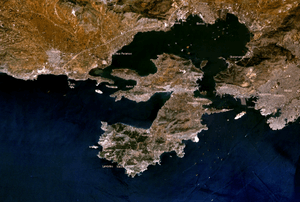Battle of Salamis facts for kids
Quick facts for kids Battle of Salamis |
|||||||||
|---|---|---|---|---|---|---|---|---|---|
| Part of the Greco-Persian Wars | |||||||||
 Satellite image of Salamis, with the straits to the mid-right |
|||||||||
|
|||||||||
| Belligerents | |||||||||
| Greek city-states | Achaemenid Empire | ||||||||
| Commanders and leaders | |||||||||
| Eurybiades, Themistocles |
Xerxes I of Persia, Artemisia I of Caria, Ariabignes † |
||||||||
| Strength | |||||||||
| 366–378 ships a | ~1,200 shipsb 600-800 ships c |
||||||||
| Casualties and losses | |||||||||
| 40 ships | 200 ships | ||||||||
| a Herodotus gives 378 ships of the alliance, but his numbers add up to 366. b As suggested by several ancient sources; c Modern estimates |
|||||||||
The Battle of Salamis was a naval battle between an Alliance of Greek city-states and the Achaemenid Empire of Persia. It happened in September 480 BC in the straits between the mainland and Salamis Island. It was part of the Greco-Persian Wars.
Although heavily outnumbered, the Greek Allies were persuaded by the Athenian general Themistocles to bring the Persian fleet to battle again. The Persian king Xerxes was also anxious for a decisive battle.
The Persian navy sailed into the Straits of Salamis and tried to block both entrances. In the cramped conditions of the Straits the great Persian numbers were an active hindrance, as ships struggled to maneuver and became disorganised. Seizing the opportunity, the Greek fleet formed in line and scored a decisive victory, sinking or capturing at least 200 Persian ships.
As a result, Xerxes retreated to Asia with much of his army, leaving Mardonius to complete the conquest of Greece. However, the following year, the rest of the Persian army was decisively beaten at the Battle of Plataea and the Persian navy at the Battle of Mycale. Afterwards the Persians made no more attempts to conquer the Greek mainland. These battles of Salamis and Plataea mark a turning point in the Greco-Persian wars; from then on, the Greek cities would take the offensive.
Images for kids
-
Ionian soldier (Old Persian cuneiform 𐎹𐎢𐎴, Yaunā) of the Achaemenid army, circa 480 BC. Xerxes I tomb relief. -
Greek trireme.
-
The Lycian dynast Kybernis (520-480 BCE) led 50 Lycian ships in the Achaemenid fleet.
-
The Ionian fleet, here seen joining with Persian forces at the Bosphorus in preparation of the European Scythian campaign of Darius I in 513 BC, was part of the Achaemenid fleet at Salamis. 19th century illustration.
-
Greek triremes at Salamis.
-
Battle of Salamis, by Wilhelm von Kaulbach (detail).
-
Artemisia, Queen of Halicarnassus, and commander of the Carian contingent of the Achaemenid fleet, at the Battle of Salamis, shooting arrows at the Greeks. Wilhelm von Kaulbach (detail).
-
The triumph of Themistocles after Salamis. 19th century illustration.
-
The wrath of Xerxes looking at the Battle of Salamis from his promontory, by Wilhelm von Kaulbach (detail).
-
Serpent Column, a monument to their alliance, dedicated by the victorious Allies in the aftermath of Plataea; now at the Hippodrome of Constantinople
See also
 In Spanish: Batalla de Salamina para niños
In Spanish: Batalla de Salamina para niños















